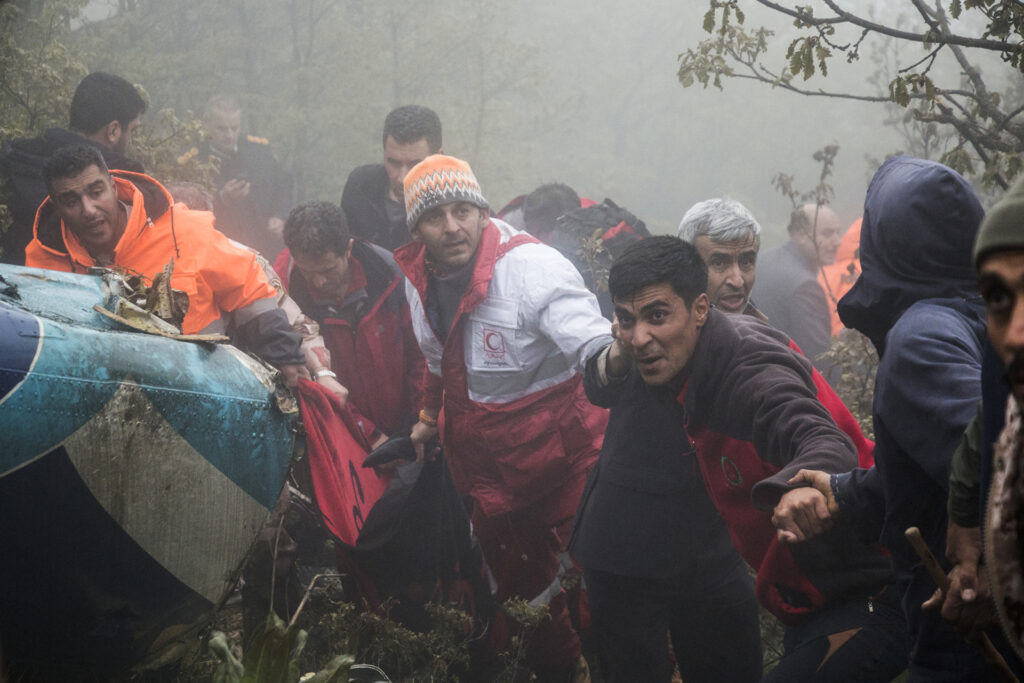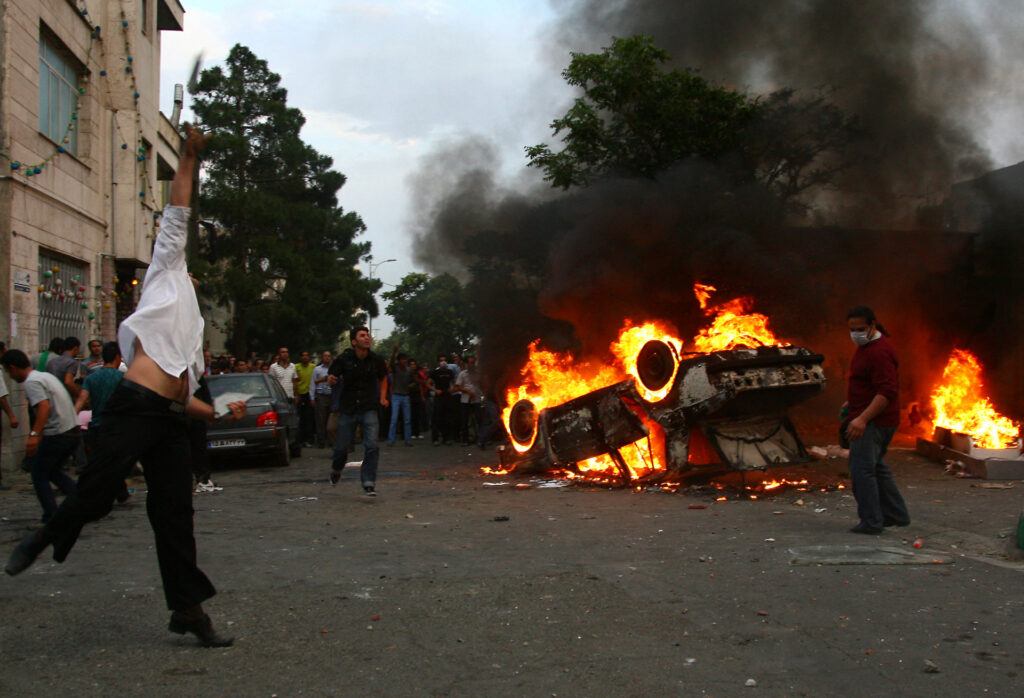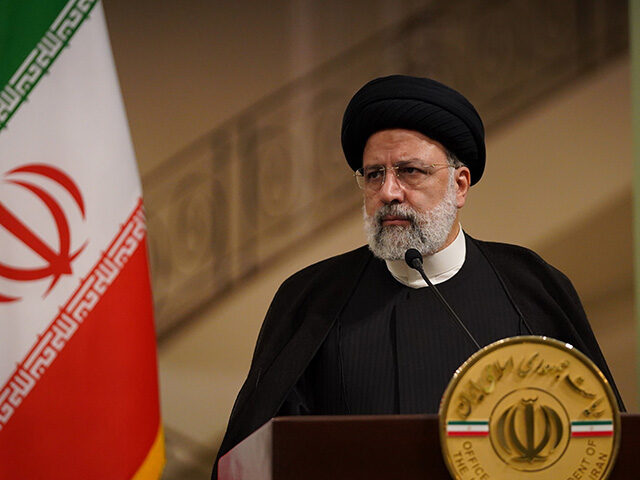Late Iranian President Ebrahim Raisi — found dead at the site of a helicopter crash on Monday in East Azerbaijan, Iran — abruptly concluded a presidency defined by the massacre of young dissidents, assumed after a lifetime of orchestrating mass murders.
The Iranian government confirmed on Monday that Raisi died alongside Foreign Minister Hossein Amir-Abdollahian and several other senior Iranian officials after their helicopter crashed into mountainous terrain in East Azerbaijan. The group was returning home from the nation of Azerbaijan, where Raisi joined genocidal tyrant Ilham Aliyev for an event inaugurating a jointly built dam.
Neither the Iranian Islamist regime nor its state media outlets have issued any statements indicating that they suspect foul play in the helicopter crash. Reports out of Tehran indicate that foggy weather made visibility difficult for the helicopter, raising questions about why authorities allowed the Iranian president to fly in inclement weather. The Islamic Republic News Agency (IRNA), a state outlet, reported that at least one passenger on the aircraft survived for an hour after the crash, but authorities did not move fast enough to save him. As of Monday, Iranian officials said the remains of all those on board had been found and identified.

Rescuers recover bodies at the crash site of a helicopter transporting Iranian President Ebrahim Raisi, Foreign Minister Hossein Amir-Abdollahian, and others in a fog-covered mountainous area of Varzaghan in northwestern Iran on May 20, 2024. (AZIN HAGHIGHI/MOJ News Agency/AFP via Getty Images)
Ayatollah Ali Khamenei, the “supreme leader” of Iran and Raisi’s boss, called the president “a warm-hearted, humble and valued servant,” declaring five days of mourning. Iranian media are referring to him as a “martyr,” implying that he died defending a religious or political cause, a conclusion the publicly known circumstances of his demise do not support.
Iranians appeared to immediately disobey the order to mourn; fireworks appeared over the skies in Tehran, and dissidents openly shared sweets to celebrate, in clear defiance of the regime, according to the anti-regime outlet Iran International.
Iranians have much to celebrate with Raisi’s untimely death. Raisi rose to power climbing the corpses of the regime’s enemies, notorious for violently suppressing calls for an end to the Islamist regime and a return to freedom for the country. Raisi rose to political prominence as a prosecutor despite his academic background in Islamic theology. Raisi took over the role of deputy prosecutor general of Tehran in 1985, at a time of significant political turmoil for the regime. The country’s most prominent opposition group, the People’s Mojahedin Organization of Iran (PMOI) and Mujahedin-e-Khalq (MEK), had made strides in organizing dissidents, particularly students and Iranian youth, to demand an end to the regime. Some estimates suggest that the Islamist regime imprisoned tens of thousands associated with the PMOI/MEK in the 1980s and executed at least 5,000 of them.
As a top prosecutor and member of what is now known as the “death commissions,” Raisi approved the executions of between 5,000 and 30,000 political prisoners. A 2018 report from Amnesty International quoted Raisi discussing the elimination of political dissent in the 1980s as “one of the proud achievements of the system” under then-“supreme leader” Ayatollah Ruhollah Khomenei.
Following his efforts to suppress pro-democracy protesters in the 1980s, Raisi spent much of the next two decades prosecuting “corruption” within the Islamic regime before ascending to the “Assembly of Experts” in 2006.
“After the disputed 2009 presidential election triggered months of public protests, Raisi backed the brutal crackdowns and mass incarcerations. He was Iran’s prosecutor general from 2014 to 2016,” a profile by the United States Institute of Peace narrated. The 2009 protests resulted in at least 100 deaths — prominently including the fatal shooting of 26-year-old peaceful protester Neda Agha-Soltan — and thousands disappeared into Iran’s draconian “legal” system.

Smoke billows from a burning car as supporters of defeated Iranian presidential candidate Mir Hossein Mousavi protest against the killing of a demonstrator outside a local base of the Islamic Basij militia in Tehran on June 15, 2009. (AFP via Getty Images)
Raisi first ran for president in the 2017 sham election, “losing” to “moderate” Hassan Rouhani, who was running for a second term. Raisi served on the Supreme National Security Council during Rouhani’s tenure — notably during the shooting down of Ukrainian International Airlines (UIA) Flight 752 in January 2020, a commercial airliner the regime attacked in the immediate aftermath of the American elimination of Iranian terror chief Qassem Soleimani. Iran killed 176 people by shooting down the plane. Officials claimed it was an error, but they bulldozed the crash site, presumably to hide evidence of what had occurred.
“We are not sorry for his death,” a statement on Monday by the Association of Families of the Ukrainian Plane Victims read.
Raisi finally ascended to the second-in-command position, the presidency, in 2021. At the time, he described himself as a “defender of human rights.”
As president, Raisi ruled with an iron fist, ordering some of the most violent repression of dissidents caught on camera in Iran. The defining moment of Raisi’s presidency was the killing of 22-year-old Kurdish woman Mahsa Amini in September 2022. Iran’s notorious “morality police” beat Amini to death for allegedly wearing her hijab incorrectly.
Amini’s death became another rallying cry for Iran’s youth, who have consistently protested demanding an end to the regime for decades. Raisi responded to the protests with the same disposition he did to dissidents in the 190s.
A year later, estimates suggested that Raisi had killed 537 people protesting the Amini killing, including some executed after being arrested for protesting. A report published in January 2023 claimed the true death toll could be in the thousands. In March 2024, a United Nations report put the death toll at 551 people, including 68 children. Many of the survivors appeared to be deliberately blinded and disfigured.
“What we found was that security forces shot at protesters and also at bystanders at very short distances in a targeted fashion, causing injuries to their heads, necks, torsos, genital areas, but particularly to the eyes,” Chair of the U.N.’s Independent International Fact-Finding Mission on the Islamic Republic of Iran Sara Hossein said at the time. “We found hundreds of protesters had these life-changing injuries, with many of them now blinded and branded essentially for life marked as dissidents.”
Independent of the Amini protests, Raisi’s tenure saw a dramatic increase in the number of state executions in Iran annually. According to Amnesty International, Iran executed 853 people in 2023 — an eight-year high — and had executed over half that number, 481, by April, suggesting the numbers would have continued to rise under Raisi.
The odds that the Iranian people will be more free following Raisi’s death are slim — Khamenei has already appointed an interim president to hold the position for 50 days before the “supreme leader” finds a permanent replacement. Regardless of who takes the position, Khamenei will struggle to find an official in his tyrannical regime with as singularly bloody a resume as Raisi.

COMMENTS
Please let us know if you're having issues with commenting.